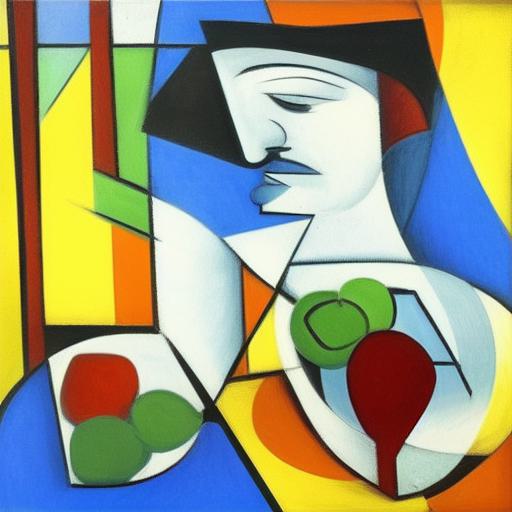How to write this prompt?
To write a prompt like the given example, you can follow the following points:
- Begin with the overall mood and tone of the image: In the above prompt, the dominant mood is a blue tone, which sets the overall atmosphere and feeling of the image.
- Identify the style and genre of the artwork: The prompt mentions cubism, which is a distinct art style characterized by geometric shapes and angles. This will influence the overall composition and structure of the image.
- Specify the subject and setting of the image: The prompt describes a beautiful man sitting at a table with fruit trees, which sets the central focus of the image and provides visual context.
- Mention the artist or inspiration for the image: The prompt references a specific artist, Bernard Accama, whose style and techniques can be emulated in the generated image.
- Add relevant keywords to enhance the image: The prompt includes keywords like figurative art, tumblr, and Picasso style, which provide additional details and inspiration for the AI to generate an image that aligns with these keywords.
Each individual part of the prompt influences the generated image in the following ways:
- Blue tone: The use of blue as the dominant color influences the overall mood and atmosphere of the image, creating a sense of calm and tranquility.
- Cubism: The cubist style of the painting affects the overall structure and composition of the image, with geometric shapes and angles replacing more traditional forms.
- Beautiful man sitting at a table with fruit trees: This provides the central subject and setting of the image, with the man and fruit trees serving as visual focal points.
- Bernard Accama: The artist referenced in the prompt provides a specific style and technique that the AI can draw upon to create an image that aligns with this particular artist’s work.
- Figurative art, tumblr, Picasso style: These additional keywords help to narrow the focus of the image, providing more specific inspiration for the AI to generate an image that meets the criteria set forth in the prompt.
What is the significance of blue in art?
Blue has been a popular color in art throughout history, with different shades of blue evoking different moods and emotions. For example, light blue can represent tranquility, while dark blue can symbolize sadness or melancholy. In the case of the above prompt, the blue tone sets a calm and serene mood for the cubist painting.
How to create a cubist painting?
Creating a cubist painting typically involves breaking down the subject into geometric shapes and reassembling them in a new way. The artist may use multiple viewpoints to depict different aspects of the subject, and may also incorporate other techniques like collage or mixed media. There is no one “right” way to create a cubist painting, as the style is known for its experimentation and individuality.
Why is Bernard Accama significant in the world of art?
Bernard Accama was a Dutch painter who lived in the 18th century and is known for his beautiful portraits and landscapes. He was highly regarded in his time and is still remembered today as one of the most important Dutch painters of the era. His work often features a delicate and nuanced use of color and light, which has influenced generations of artists after him. In the case of the above prompt, referencing Bernard Accama provides specific inspiration for the AI to generate a cubist painting with a similar style and technique.
What is the future of AI art generation?
The future of AI art generation looks promising. As AI technology continues to improve, we can expect to see even more advanced AI systems capable of creating highly sophisticated and realistic artworks. Currently, AI art generation is primarily focused on creating visual artworks, such as paintings, drawings, and digital images. However, in the future, we may see AI systems capable of generating other forms of art, such as music or poetry. Moreover, AI art is likely to become more prevalent in the art world, as artists and collectors alike recognize its potential as a valuable and unique creative medium.
Can AI-generated art be improved or edited by humans?
Yes, AI-generated art can certainly be improved or edited by humans. While AI systems are capable of creating highly sophisticated and original artworks, they are still limited by their programming and lack the creative intuition of a human artist. Therefore, human intervention is often necessary to refine and enhance an AI-generated artwork. For example, an artist or curator may adjust the color balance or composition of an AI-generated painting, or add additional layers or textures to a digital image. Alternatively, a human artist may collaborate with an AI system to create a hybrid artwork that combines the best aspects of both human and machine creativity. In this way, AI-generated art can be seen as a tool that can be used in collaboration with human artists to create unique and innovative artworks.
Visualize your ideas like never before with the power of AI-generated art and design tools from Visual Paradigm Online. Elevate your designs to the next level by effortlessly integrating stunning graphics with just a few clicks. With a user-friendly interface and a vast selection of design templates and assets at your disposal, you can explore and experiment with various styles and layouts until you create the perfect masterpiece. Discover the limitless potential of AI-generated art and transform your creative vision into reality with Visual Paradigm Online.


